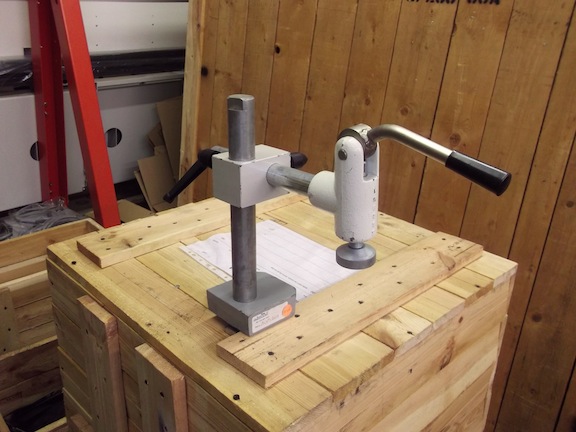Milling Raised Door Panels
Should you run the pieces face up, or face down, asks a cabinetmaker? Opinions, and the reasons for them, vary. October 30, 2005
Question
I make my raised panels face up, rather than down. What do you do, and more importantly, why?
Forum Responses
(Solid Wood Machining Forum)
From contributor M:
By running them face up, you will always get a uniform tongue thickness, plus you can always see if you have chosen the best face.
From contributor R:
Contributor M makes a valid point regarding the tongue thickness if there is variation in thickness from panel to panel. The best face can easily be selected prior to machining, face up or face down, so it is a non-issue - careful stock preparation eliminates the first concern.
When running any profile on a shaper, particularly when hand feeding or pattern shaping, it is best to set up with the largest extension of the knife below the work piece. I generally run face down for this reason.
From contributor G:
I disagree with contributor R. We are all human and make mistakes. Even with careful stock prep, you can set down a panel incorrectly. You get interrupted and it can easily happen. Run face up to keep uniform panel thickness and to see any defects before it's too late. I highly recommend a feeder for all shaper work, especially panel raising. If no feeder is used, install a cutter guard of some sort, even if it is shop made.
From contributor F:
Always seemed strange to put the work between the table top and the cutter... that is why I run them face down more than anything. If your panels are varying thicknesses (by a small amount), then if you run them face up, where does the error show up? On the face! Might be a problem with some profiles. I could always put a back cutter on when running them face up if they were too thick for the grooves.
From contributor L:
I always run mine face up, specifically for the constant tongue thickness. Wood from my supplier seems to vary + - 1/32", which in tongue thickness can be make or break. I keep my thickness at 2-4 thousandths smaller than my groove, tight enough to hold the panel in place but loose enough for it to expand and contract seasonally. The only reason I would run a panel face down is because of using a router setup. And I do use a stock feeder for safety and convenience.
From contributor B:
On the subject of feeders, anyone know of a feeder used for the irregular shaping of a cathedral panel? I have Weaver shapers and the feeders on them only feed straight line, leaving me to feed the tops by hand.
I also feed panels face up for tongue consistence thickness.
From contributor H:
I run mine face down with a back cutter. In this way, the face and tongue are always the same - variances are on the back.
Sunhill has a one wheeled feeder designed for curved work. I have seen it demoed at shows but never used one.
From contributor W:
One condition that makes me run mine face up is that my PM model 26's don't have dust collection under the cabinet. The nature of the cutting angle of my Freeborn cutters would direct all shavings down into my cabinet, which I would have to clean out by hand instead of the dust collector doing it automatically. I use a shop build dust hood over the top of the spindles to direct the flow.
From contributor W:
Contributor B, you should be using an air float system for your arched raised panels, like the one from Reliable Cutting Tools called a Panelcrafter, which you would feed by hand anyway.
From contributor J:
We tilt the feeder up on its nose so only one wheel touches the work when feeding curves.
From contributor W:
Contributor J, what do you use as a pattern for your arched tops if you're feeding with a feeder and how do you get the feeder to make the arch constantly contact the guide bearing when cutting cathedral arches?
From contributor U:
Posted by: bruce 5/3 [ #13 -- Re: raised panels, face up or down ]
btbean@misn.com
We run panels face up. If you're running face down, which direction do you feed? Left to right? Also, how well does the Weaver power feeder work?
From contributor F:
When running face down, I move the stock into the cutter, usually from right to left, cutter going counter clockwise.
From contributor G:
Weaver feeders work great. The variable speed is great and so are the feed belts. Far better than a 3 or 4 roller feeder. I have four Weaver feeders and four 3-4 wheel roller feeders. I wish all eight were Weavers.
From contributor J:
Contributor W, we use this nose down feeder technique with an Aigner Bowmould Master, more for entry doors with curved parts than cabinet doors. Usually with the jig on top or sometimes with a pre-shaped part that rides against the Bowmould. Do not put a lot of pressure on the feeder and with a little hand pressure, you can keep it tight against the Bowmould as it moves through. It is a safe process with this attachment. Back when we had dedicated shapers and Weaver jigs, we used to do the same thing on a pre-shaped panel with the cutter on top with the little Weaver ring under. If you do a lot of arch cabinet doors, the air jig is a good investment.
We feed all our straight panels face up using an Aigner flatserver. It is a quick setup and safe, also.
From contributor O:
Face up - more material on the table, safer.
From contributor A:
Try running a 4 1/2" wide panel face down.
